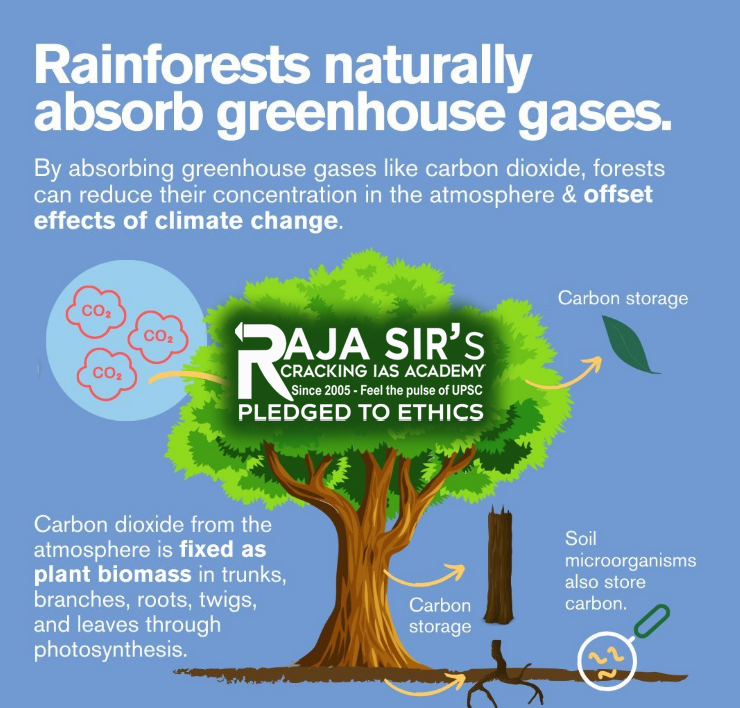- Home
- Prelims
- Mains
- Current Affairs
- Study Materials
- Test Series
From Sink to Source: The Changing Carbon Role of Rainforest
- Tropical rainforests are among the Earth’s most vital ecosystems — they absorb large amounts of carbon dioxide (CO₂) and help regulate the planet’s climate.
- For decades, they have acted as “carbon sinks”, mitigating greenhouse gas emissions and serving as buffers against climate change.
- However, new research (published in Nature by scientists in Australia, October 2025) reveals that some tropical rainforests are now releasing more CO₂ than they absorb, effectively becoming net carbon emitters.
Key Findings of the New Research (Australia Study, 2025)
- The study, spanning nearly five decades of forest-data from Queensland, shows:
- The woody biomass (tree trunks, branches, and stems) in tropical rainforests has changed from being a carbon absorber to a carbon source.
- The principal cause identified is higher tree mortality — more trees are dying than regenerating.
- Extreme heat, drought stress, and cyclones are increasing both the rate and severity of tree deaths.
- Scientists describe this phenomenon as a “canary in the coal mine”, warning that similar transitions could occur in other tropical forests worldwide.
- The study challenges current carbon-cycle models, which might be overestimating tropical forests’ capacity to offset fossil-fuel emissions.

Global Context: Forest Decline Worldwide
- 2025 Forest Declaration Assessment Report
- In 2024 alone, 8.1 million hectares of forest were lost worldwide.
- This loss is 63% higher than the path required to end deforestation by 2030, a goal set at COP26 (Glasgow, 2021).
- The rate of destruction of humid primary tropical forests — the most carbon-dense — remains alarmingly high.
- Agricultural expansion (86 % of deforestation) and forest fires are the top causes.
- Forest degradation (from logging, fire, fragmentation) affected another 8.8 million ha in 2024.
- Global Implications
- The combined effect of forest-area loss and declining carbon-sink function signals an accelerating breakdown of natural carbon regulation systems.
- Countries’ pledges to restore degraded land and forests — including India’s Bonn Challenge commitments — are falling short of targets.
Implications of Rainforests Becoming Net Emitters
- For Climate Change and Carbon Budgets
- Tropical forests have historically absorbed ~30% of anthropogenic CO₂ emissions.
- If they now become sources instead of sinks, the global carbon budget tightens drastically.
- Climate models that project temperature increases based on current sink capacities might underestimate future warming.
- The transition undermines global goals to achieve net-zero by mid-century.
- For Biodiversity and Ecosystem Services
- Rainforests regulate rainfall, prevent soil erosion, and stabilise local temperatures.
- Their degradation disrupts rainfall patterns across regions (e.g., Amazon dieback could affect Indian monsoon circulation).
- Biodiversity loss accelerates when canopy gaps expand and invasive species colonise disturbed areas.
- Collapse of keystone species (e.g., pollinators, seed dispersers) can cause cascading ecological failures.
- For Indigenous and Local Communities
- Over 1.6 billion people globally depend on forests for livelihoods.
- Deteriorating forest health threatens food security, traditional medicine, and cultural identity.
- Reduced forest productivity increases poverty and migration pressures among forest-fringe populations.
- For Global South and India
- India’s tropical and subtropical forests (Western Ghats, Northeast, Andaman) could face similar stress.
- A decline in global forest carbon sinks raises the urgency of India’s afforestation and restoration programmes.
- Indian forests are also important for monsoon regulation, soil moisture retention, and biodiversity conservation.
- National programmes like the Green India Mission and National Forest Policy (2023 Draft) must now integrate forest resilience and mortality data into planning.
Way Forward
- Policy and Governance Measures
- Halt Deforestation: Enforce moratoriums on primary-forest clearing; strengthen laws against illegal logging.
- Strengthen Monitoring: Move beyond mere “forest cover” data to include forest vitality, carbon fluxes, and mortality rates.
- Integrate Climate and Forest Policies: Align national climate action plans (NDCs) with biodiversity and forest policies.
- Empower Local Communities: Involve indigenous people in forest management; grant legal land rights and benefit-sharing mechanisms.
- Scientific and Technological Steps
- Enhance Long-Term Observation Networks: Expand permanent forest plots across continents to track mortality and regeneration trends.
- Improve Carbon-Cycle Models: Include temperature thresholds, drought stress, and cyclone impacts in Earth System Models.
- Develop Climate-Resilient Species Mix: Promote reforestation using native, drought- and heat-resistant species.
- Financial and Economic Reforms
- Redirect Subsidies: Shift from agriculture-driven deforestation subsidies toward forest conservation funding.
- Increase Climate Finance: Double international support for forest-rich developing nations under mechanisms like REDD+.
- Valuing Ecosystem Services: Incorporate forest carbon and biodiversity into natural capital accounting frameworks.
- India-Specific Measures
- Implement the Green Credit Programme: Incentivise private entities to fund verified forest restoration.
- Use Remote-Sensing for Forest Health: Monitor not just area but carbon density, canopy stress, and biodiversity indices.
- Link with National Adaptation Plans: Recognise forests as natural infrastructure for climate resilience — flood prevention, water regulation, and temperature moderation.
- Public Awareness and Education
- Promote understanding that forests are not infinite carbon absorbers; human emissions must decline sharply.
- Encourage sustainable consumption: reduced meat intake, less deforestation-linked commodities, and re-greening urban spaces.









 Latest News
Latest News
 General Studies
General Studies